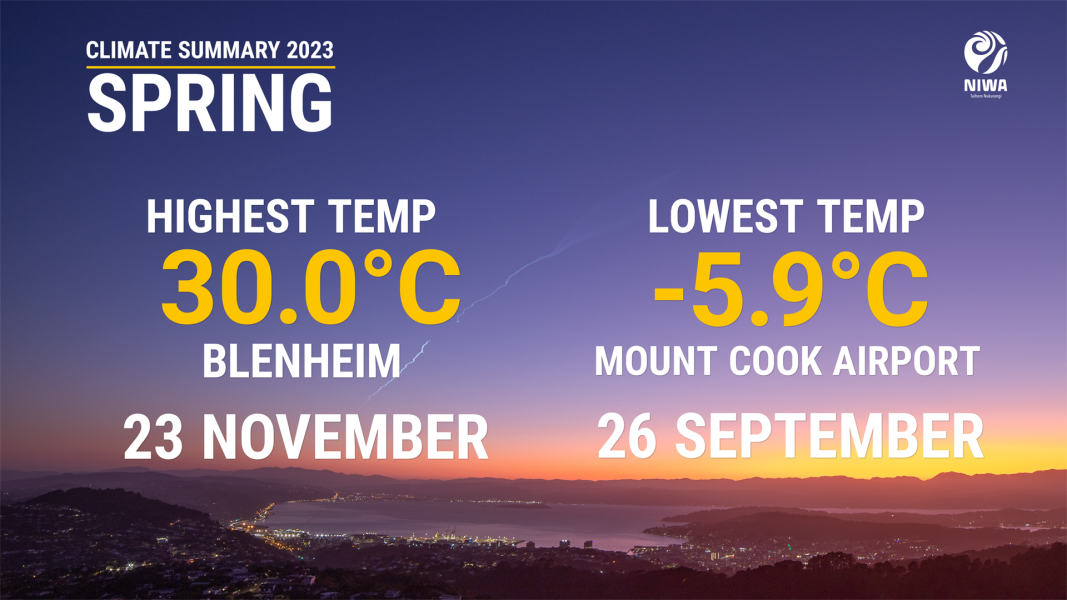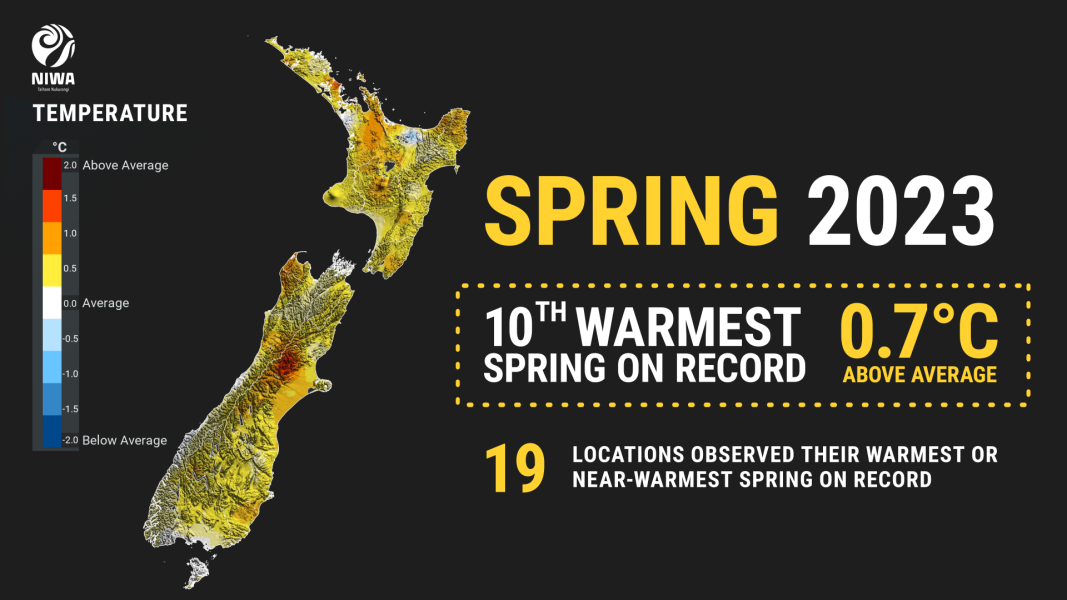A mild spring, very wet for parts of the North Island
| Temperature | Spring temperatures were above average (+0.51°C to +1.20°C of average) for many parts of the country. The exceptions were coastal parts of the North Island from Taranaki to Wellington, Nelson, West Coast, coastal northern Canterbury, inland parts of Otago, and western and southern parts of Southland, where temperatures were near average (±0.50°C of average). |
| Rainfall | Rainfall was well above normal (>149% of normal) in Gisborne, northern Hawke’s Bay, and central Northland. Above normal (120-149% of normal) rainfall was observed in Bay of Plenty, southern Waikato, coastal parts of southern Hawke’s Bay and Wairarapa, and inland parts of Otago. In contrast, rainfall was below normal (50-79% of normal) in parts of the Greater Wellington region, the northern South Island, and Banks Peninsula. Elsewhere, rainfall was generally near normal (80-119% of normal). |
| Soil moisture | At the end of spring, soil moisture levels were well above normal for eastern and inland parts of the North Island from western Bay of Plenty to Wairarapa, as well as the Far North. Below normal soil moisture levels were observed in western Waikato, Kāpiti Coast, Wellington, southern Canterbury, South Otago, and southern Southland. Elsewhere, near normal soil moisture levels were observed. |
Overview
Spring 2023 was characterised by a large area of higher-than-normal mean sea level pressure (MSLP) over and surrounding Aotearoa New Zealand. This generally resulted in more northeasterly winds than normal for eastern and northern parts of the North Island, with westerly winds prevailing for the lower South Island. El Niño strengthened in the tropical Pacific during the season, with several strong westerly wind events signalling its building influence across New Zealand.
Temperatures were relatively warm for the season overall, with above average temperatures (+0.51°C to +1.20°C of average) observed in parts of every region of the country. Overall, the nationwide average temperature for spring was 12.8°C, 0.7°C above the 1991-2020 average from NIWA’s seven-station temperature series which begins in 1909. This ranked as New Zealand’s 10th-warmest spring on record.
It was a very wet season in Gisborne, northern Hawke’s Bay, and central parts of Northland. Rainfall was well above normal (>149% of normal) in these areas, with some locations receiving more than double their usual spring rainfall. In contrast, it was a dry season in parts of the Greater Wellington region, with Upper Hutt, Martinborough, and Paraparaumu each receiving little more than half of their normal spring rainfall (rainfall totals ranged from 57-59% of normal, respectively). Rainfall was also below normal (50-79% of normal) in Tasman, Nelson, Marlborough, and Banks Peninsula.
Further highlights for spring 2023
- The highest temperature was 30.0°C, observed at Blenheim on 23 November.
- The lowest temperature was -5.9°C, observed at Mount Cook Airport on 26 September.
- The highest 1-day rainfall was 234 mm, recorded at Milford Sound on 20 September.
- The highest wind gust was 246 km/h, observed at Cape Turnagain on 17 September.
- Of the available, regularly reporting sunshine observation sites, the sunniest four regions in 2023 so far are wider Nelson (2397 hours), Mackenzie Basin (2330 hours), Tasman (2323 hours), and Taranaki (2292 hours).
- Of the six main centres in spring 2023, Auckland was the warmest, Dunedin was the coolest and equal-driest, Christchurch was the sunniest and equal-driest, Tauranga was the wettest, and Wellington was the least sunny.


